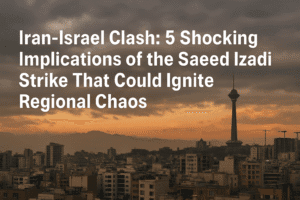Iran-Israel Clash: 5 Shocking Implications of the Saeed Izadi Strike That Could Ignite Regional Chaos
Israel’s assassination of Saeed Izadi—head of Iran’s Quds Force “Palestine Corps”—in a Qom airstrike cripples Tehran’s proxy warfare network across Gaza, Lebanon, and Yemen. This surgical strike reveals Israel’s shift from retaliation to dismantling Iran’s asymmetric threat infrastructure. Simultaneously, attacks near Isfahan’s nuclear site signal Israel’s resolve to enforce red lines on weapons development. Defense Minister Katz’s explicit threat against Khamenei marks a dangerous rhetorical escalation, while India’s evacuation of third-country nationals underscores the conflict’s regional spillover. Israel gambles that decapitating Iran’s command chain will deter aggression, but Tehran now faces a critical choice: escalate or rebuild covertly—with the shadow war at its most volatile tipping point.

Iran-Israel Clash: 5 Shocking Implications of the Saeed Izadi Strike That Could Ignite Regional Chaos
The confirmed killing of Saeed Izadi – head of Iran’s elite Quds Force “Palestine Corps” – in an Israeli airstrike near Qom marks a dangerous evolution in the Iran-Israel conflict. Unlike recent tit-for-tat missile volleys, this surgical strike on a senior commander reveals Israel’s shift toward decapitating Iran’s proxy warfare infrastructure. Here’s what this means:
- The Palestine Corps: Iran’s Linchpin for Regional Proxy Warfare
Izadi wasn’t a conventional military leader. His unit specialized in arming, training, and coordinating militant groups across Gaza, Lebanon, Syria, and Yemen. Eliminating him disrupts Iran’s weapons pipelines to Hezbollah and Hamas at a critical juncture. This signals Israel’s intent to dismantle Iran’s asymmetric threat network, not just retaliate for attacks.
- The Qom Strike: A Message to the IRGC
Targeting Izadi in Qom—a holy city housing IRGC command centers—demonstrates Israel’s intelligence penetration. Striking deep inside Iran, far from border regions, exposes vulnerabilities in Iran’s security apparatus. The unconfirmed IRGC response suggests internal turmoil or strategic hesitation.
- Nuclear Sites as Battlegro
Concurrent strikes near Isfahan’s nuclear facility (per Fars News) reveal Israel’s two-front strategy:
- Tactical: Degrade missile/radar capabilities (as IDF stated)
- Strategic: Reinforce red lines on nuclear advancement
Iran’s swift “no radiation leak” declaration underscores its sensitivity to nuclear perceptions.
- Regional Diplomacy in the Crossfire
India’s evacuation of Nepalese/Sri Lankan citizens via Iran highlights spillover effects. Smaller nations increasingly rely on regional powers for crisis mediation—a tacit acknowledgment that global institutions are sidelined.
- Katz’s Ultimatum: A Dangerous Threshold
The Israeli Defense Minister’s explicit threat against Khamenei (“this man should not continue to exist”) crosses a rhetorical Rubicon. Such language typically precedes sustained assassination campaigns, risking uncontrolled escalation.
Why This Matters Now
The Izadi strike isn’t merely retaliation; it’s a calculated escalation targeting Iran’s expeditionary capabilities. Success hinges on whether Israel can degrade IRGC coordination faster than Iran rebuilds it. With both nations avoiding all-out war but embracing targeted killings, the shadow conflict enters its most volatile phase.
You must be logged in to post a comment.